Top-class art treasures of the ancient Mycenaean high culture for the first time in Germany. The Badische Landesmuseum in Karlsruhe, Germany, shows how the Mycenaeans lived, what they believed in and with which they adorned themselves.
-
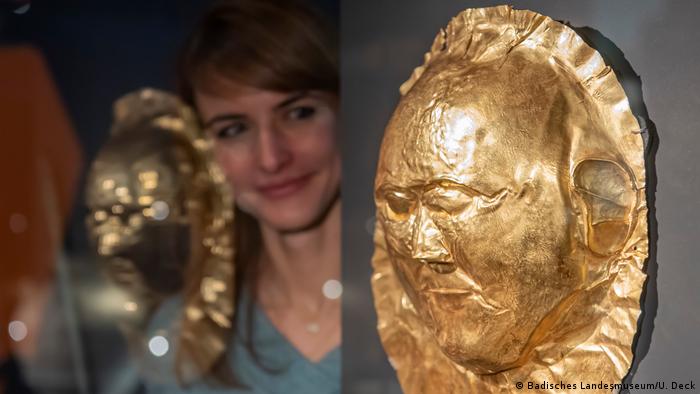
Mycenae-exhibition: The fabulous world of Agamemnon
A footprint for eternity
This gold mask from the time around 1600 BC, is one of the Highlights of the special exhibition “Mycenae – The fabulous world of Agamemnon”. From Greece 400 ancient objects for the Show to come, many have left the country before. Heinrich Schliemann discovered the round-faced gold mask in 1876 during excavations in the Greek Mycenae.
-
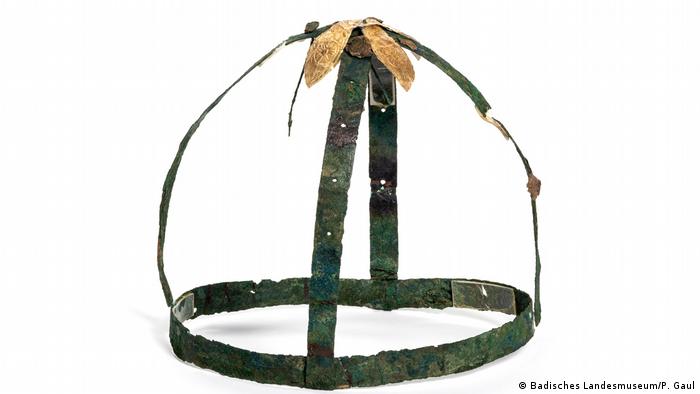
Mycenae-exhibition: The fabulous world of Agamemnon
Crown or helmet?
Happy circumstances have led to one of the well-stocked Tholos tombs from Routsi, grave robbers spared. But found “crown of Routsi” from the 15. to 16. Century before Christ, is a mystery: “Some see this as the priestesses crown,” said Co-curator Bernhard Steinmann, “the other more of a precious helmet.”
-
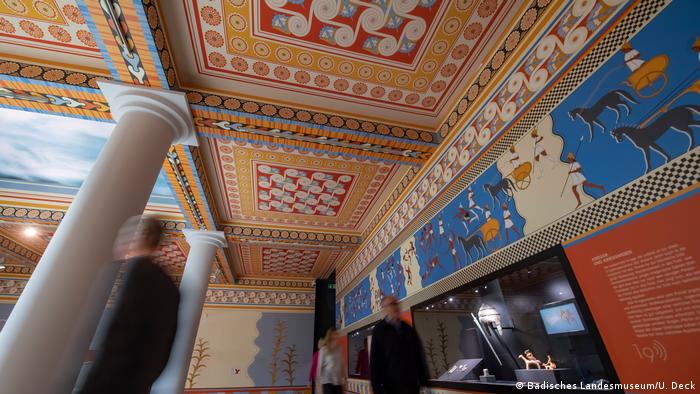
Mycenae-exhibition: The fabulous world of Agamemnon
Greek Secrets
The power center of a Mycenaean Palace the Megaron with a throne room. Here the ruler held political and religious ceremonies. Exhibition visitors can now walk through the impressive replicas and Ironing cans, ornate Palace vases, amphorae, frescoes, swords, and jewels of Gold and precious stones, from a time long past to admire.
-
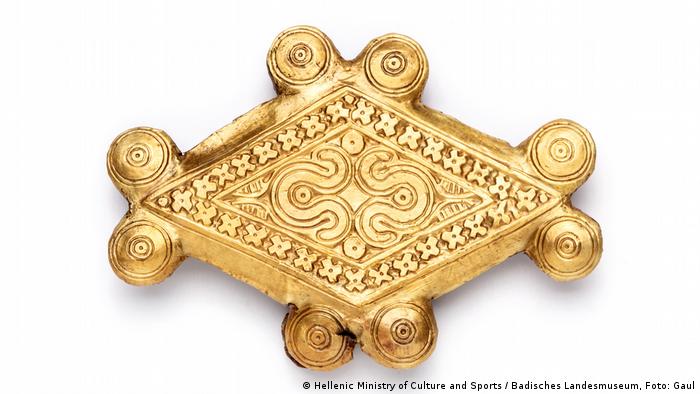
Mycenae-exhibition: The fabulous world of Agamemnon
Mycenaean Value Work
Mycenaean artists were known for their masterful goldsmith’s craft. This button is from the 16. Century before Christ, comes from the shaft graves of Mycenae was excavated in 1876 by Heinrich Schliemann. He is in the core of carved bone, which was then covered with gold plate. The spiral ornamentation is typical for the art of the early Mycenaean era.
-
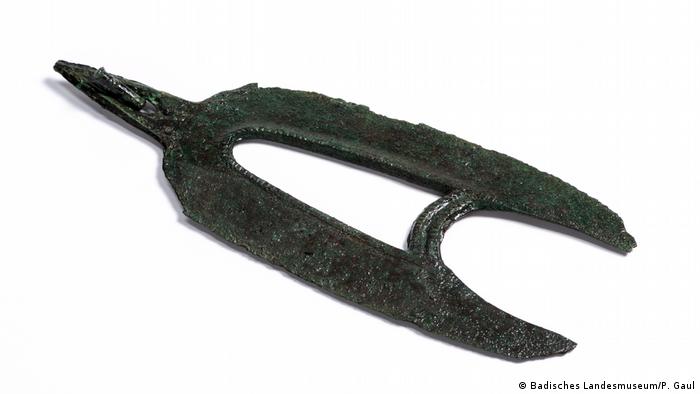
Mycenae-exhibition: The fabulous world of Agamemnon
Practical Everyday Helpers
Regular body maintenance also Mycenaean heroes could not do without. As the gentlemen went in for the connection of their beards-this is a bronze razor would suggest. The practical everyday helpers found himself in addition to Mirrors, ceramics, jewelry and weapons found in tombs Dating from the early 12th century. Century before Christ. Now he hangs in the Baden state Museum in Karlsruhe.
-
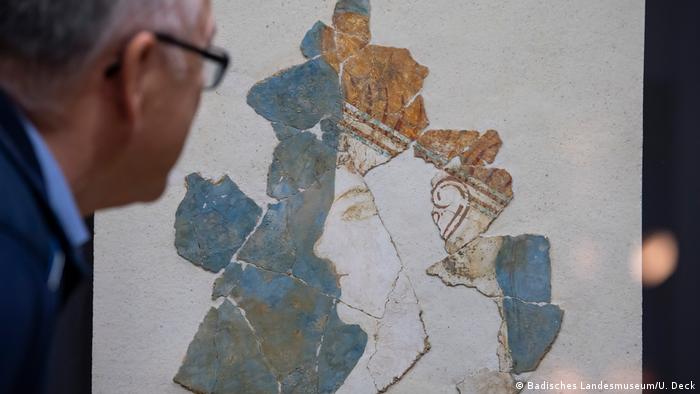
Mycenae-exhibition: The fabulous world of Agamemnon
The Beautiful from the ancient times
The mouth slightly open, staring straight ahead, the so-called “White goddess survived” from the Palace of Pylos from the 13th century. Century before Christ, the centuries. Ancient frescoes and paintings like this one that invite you to delve into the Details. This Fragment of the Karlsruhe Mycenae Show is one of the highlights.
-
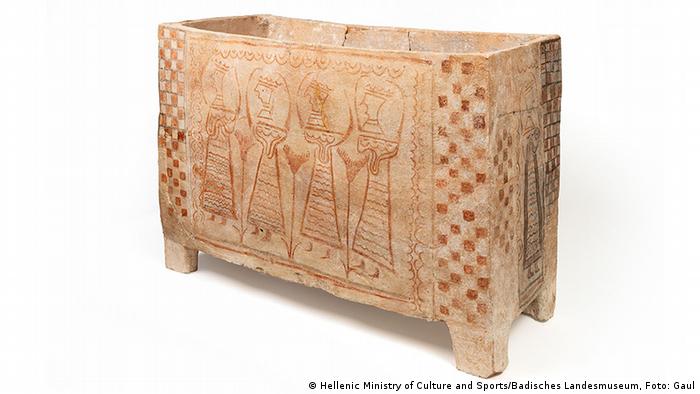
Mycenae-exhibition: The fabulous world of Agamemnon
The Mycenaean Cult Of The Dead
Four women form a funeral procession and to decorate this Larnax from the 13. Century before Christ. The Larnax is a coffin-like chest made of wood or clay, which served for the burial of the dead. Beige idols, miniature vessels and glass jewelry were often. This Urn is made from clay and originated from Tanagra in Boeotia.
-
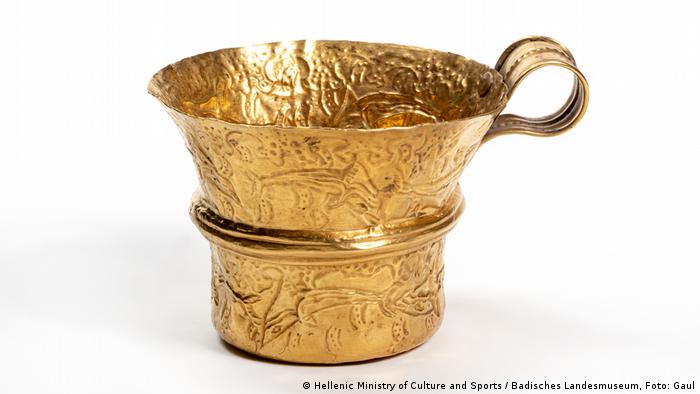
Mycenae-exhibition: The fabulous world of Agamemnon
Dazzling for the Beyond
Wealthy deceased have were precious possessions with you on your last trip. This gold Cup has been found, a German archaeologist and businessman Heinrich Schliemann in the excavation of the shaft graves of Mycenae. It shows dolphins swimming in an underwater landscape.
-
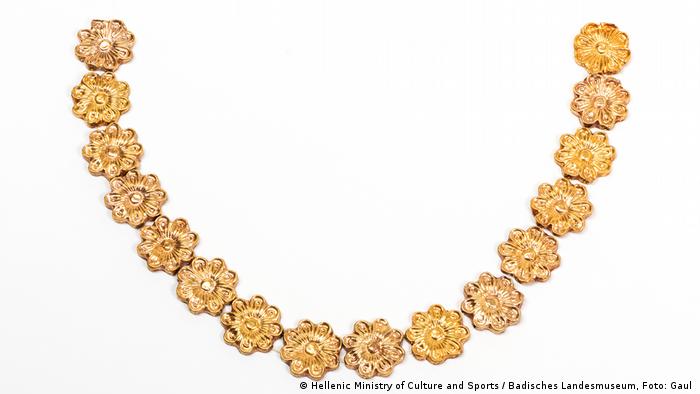
Mycenae-exhibition: The fabulous world of Agamemnon
Artful Treasures
Gold jewelry has fascinated people at all times. Such precious jewels, however, remained reserved for the Elite. The intricately crafted necklace dates back to the 14th century. Century before Christ, and combines eight-petalled rosettes made of gold sheet metal. While the Palace of the time, especially ornaments of Gold and glass beads.
-
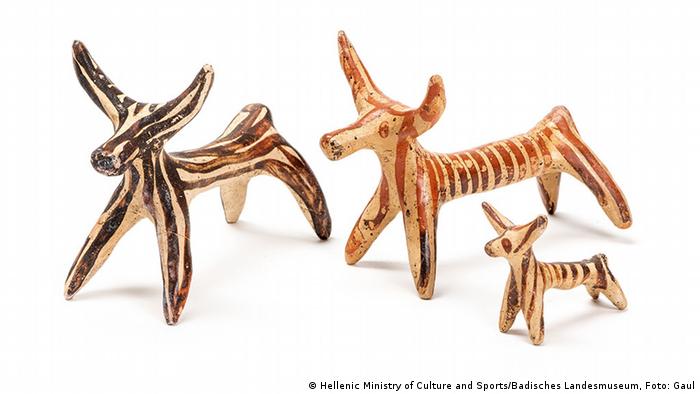
Mycenae-exhibition: The fabulous world of Agamemnon
Sacrifice or children’s toys?
This bull’s figures of the science puzzles on: Although they were not uncommon in Mycenaean settlements, and were even quite often. However, until today, it is open whether they should be expressions of popular piety or whether they were gifts of the Mykenern as a victim. It is also possible to use as a children’s toy would be.
Author: Isabel Surges
-

Mycenae-exhibition: The fabulous world of Agamemnon
A footprint for eternity
This gold mask from the time around 1600 BC, is one of the Highlights of the special exhibition “Mycenae – The fabulous world of Agamemnon”. From Greece 400 ancient objects for the Show to come, many have left the country before. Heinrich Schliemann discovered the round-faced gold mask in 1876 during excavations in the Greek Mycenae.
-

Mycenae-exhibition: The fabulous world of Agamemnon
Crown or helmet?
Happy circumstances have led to one of the well-stocked Tholos tombs from Routsi, grave robbers spared. But found “crown of Routsi” from the 15. to 16. Century before Christ, is a mystery: “Some see this as the priestesses crown,” said Co-curator Bernhard Steinmann, “the other more of a precious helmet.”
-

Mycenae-exhibition: The fabulous world of Agamemnon
Greek Secrets
The power center of a Mycenaean Palace the Megaron with a throne room. Here the ruler held political and religious ceremonies. Exhibition visitors can now walk through the impressive replicas and Ironing cans, ornate Palace vases, amphorae, frescoes, swords, and jewels of Gold and precious stones, from a time long past to admire.
-

Mycenae-exhibition: The fabulous world of Agamemnon
Mycenaean Value Work
Mycenaean artists were known for their masterful goldsmith’s craft. This button is from the 16. Century before Christ, comes from the shaft graves of Mycenae was excavated in 1876 by Heinrich Schliemann. He is in the core of carved bone, which was then covered with gold plate. The spiral ornamentation is typical for the art of the early Mycenaean era.
-

Mycenae-exhibition: The fabulous world of Agamemnon
Practical Everyday Helpers
Regular body maintenance also Mycenaean heroes could not do without. As the gentlemen went in for the connection of their beards-this is a bronze razor would suggest. The practical everyday helpers found himself in addition to Mirrors, ceramics, jewelry and weapons found in tombs Dating from the early 12th century. Century before Christ. Now he hangs in the Baden state Museum in Karlsruhe.
-

Mycenae-exhibition: The fabulous world of Agamemnon
The Beautiful from the ancient times
The mouth slightly open, staring straight ahead, the so-called “White goddess survived” from the Palace of Pylos from the 13th century. Century before Christ, the centuries. Ancient frescoes and paintings like this one that invite you to delve into the Details. This Fragment of the Karlsruhe Mycenae Show is one of the highlights.
-

Mycenae-exhibition: The fabulous world of Agamemnon
The Mycenaean Cult Of The Dead
Four women form a funeral procession and to decorate this Larnax from the 13. Century before Christ. The Larnax is a coffin-like chest made of wood or clay, which served for the burial of the dead. Beige idols, miniature vessels and glass jewelry were often. This Urn is made from clay and originated from Tanagra in Boeotia.
-

Mycenae-exhibition: The fabulous world of Agamemnon
Dazzling for the Beyond
Wealthy deceased have were precious possessions with you on your last trip. This gold Cup has been found, a German archaeologist and businessman Heinrich Schliemann in the excavation of the shaft graves of Mycenae. It shows dolphins swimming in an underwater landscape.
-

Mycenae-exhibition: The fabulous world of Agamemnon
Artful Treasures
Gold jewelry has fascinated people at all times. Such precious jewels, however, remained reserved for the Elite. The intricately crafted necklace dates back to the 14th century. Century before Christ, and combines eight-petalled rosettes made of gold sheet metal. While the Palace of the time, especially ornaments of Gold and glass beads.
-

Mycenae-exhibition: The fabulous world of Agamemnon
Sacrifice or children’s toys?
This bull’s figures of the science puzzles on: Although they were not uncommon in Mycenaean settlements, and were even quite often. However, until today, it is open whether they should be expressions of popular piety or whether they were gifts of the Mykenern as a victim. It is also possible to use as a children’s toy would be.
Author: Isabel Surges
It is the largest cultural-historical exhibition of the Mycenaean Greece and worldwide! The Badische Landesmuseum in Karlsruhe, thanks to its scientific collaboration with Greece, it helps for years in the fight against illegal robbery and trade in ancient cultural artifacts.
“Mycenae – The fabulous world of Agamemnon” presents more than 400 objects on loan, many have to leave the historical Land. “We do all the Mycenaean culture, from its beginnings until their demise,” says Dr. Bernhard Steinmann, Co-curator of the exhibition.
The First High Culture Of Europe
The time of Mycenae, named after one of the most important cities of Greece in the pre-time – produced between 1600 and 1200 BC the first high culture on the European mainland. Important cult and everyday objects from this period are now on display in Karlsruhe, Germany.
As soon as visitors pass through the historic Casting of the huge Löwentors, immerse yourself in a bygone time. Huge photos document the pioneering excavations Mykenes. Bronze weapons, tools of bloody Wars, and precious burial objects made of Gold and silver tell of great riches. The original-size replica of the throne room, which is based on the surviving ground plans of the Palace of Pylos, immerses visitors in the Mycenaean world, in which they are allowed to take as once the king, on the throne.
Homer as a guide
More than 400 ancient objects tell the story of the life of high culture, the spread between 1600 and 1200 BC, about Greece. A major role of Paris, son of Trojan king Priam, abducted the beautiful Helen and so the wrath of the Greeks, king Agamemnon drew: Homer depicts in his “Iliad,” a section of the Trojan war played. Heinrich Schliemann (1822-1890), archaeologist and discoverer of the bronze age city of Troy, was firmly convinced of the truth of the Tradition.
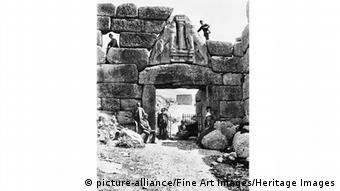
Heinrich Schliemann with colleagues in the excavations of the lion gate, the main entrance to the ancient city of Mycenae
In 1874, he traveled at the age of 52 years in the Greek Mycenae, the centre of power of Agamemnon, and landed just two years later, a sensational discovery. During his excavations, he discovered a grave with three skeletons, and numerous grave goods: vessels made of Gold, silver and Bronze, bracelets, tiaras, swords, and lances. The real Sensation, however, consisted of two intricately-crafted gold masks. In a mask Schliemann saw the face of the legendary Agamemnon. He was believed to be the tomb of the Homeric heroes encountered. Scientists discovered later: The tomb may not be his final resting place. The masks from the Mycenaean tomb are 400 years older.
A thriving high culture
There was the Greek king really? That is, until today, without a doubt. The city, however, and has been attributed to Homer, actually exists. Imposing Fortresses of Cyclops walls are to be found in Pylos, Athens, Tiryns, and Thebes, where impressive wall paintings of tell from the late Mycenaean time of the hunting of wild animals, battling warriors, and women in magnificent robes. Great palaces served as the social focal points of diplomatic and economic relations with other Mycenaean kingdoms and cultures were maintained.
Europe’s first bureaucrats
In addition to architecture and objects of art of the Mycenaean civilisation has left its mark, font products. The on clay tablets surviving texts of A witness, however, not of historical events, but of transactions, and outputs of traded goods, or lists of groups of people. They document a hierarchical, bureaucratic management system.
Mysterious Demise
15. up to the 12. Century BC, the Mycenaean culture dominated the Peloponnese. However, after just 400 years, the Kingdom disappeared on unerfind’s way: natural disasters or internal wars could have resulted in the demise around 1200 BC. Scientists have been puzzling over the reasons.
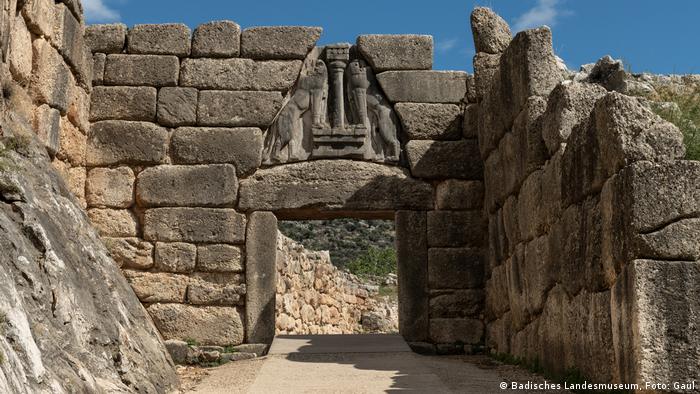
The monumental lion gate at Mycenae was a Symbol of Power and Superiority
Get mighty tomb of remained plants, more opulent gold jewelry and a variety of bronze weapons. Funerary conclusions as to the life or social position of the best to be buried. Paintings and engravings of art and cult objects serve as a source of information. The finest ceramics, and filigree gold jewelry, tools of high-art craftsmanship. The influence of the Minoan culture on the style and Form is unmistakable. “The Mycenaean art it is possible, the templates from the Minoan Crete abstrahierend implement and use emblem adhesive again and again,” says curator Steinmann.
The exhibition “Mycenae – The fabulous world of Agamemnon” from the 1. December 2018 up to 2. June, 2019.











